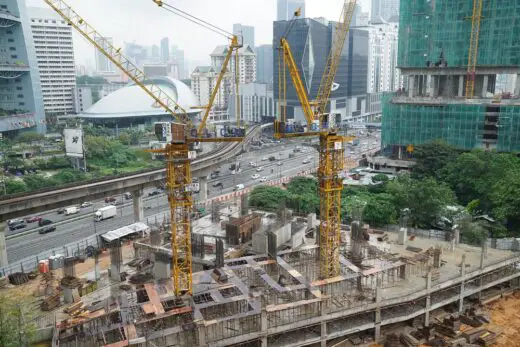Building better communities with construction technology, Impact of technology on the construction industry guide
Building Better Communities with Construction Technology
9 April 2024
The advent of reality capture in construction has ushered in a new era for building better communities. By leveraging sophisticated imaging and data collection, this technology is not just transforming the way structures are erected but also ensuring that they are more aligned with the needs and aspirations of the communities they serve. As we delve into the myriad ways construction technology is being utilized to foster healthier, safer, and more equitable spaces, the pivotal role of such innovations becomes undeniably clear.
Economic and Environmental Returns
At the intersection of economic viability and environmental stewardship lies the opportunity to redefine the impact of construction projects on our communities. By emphasizing the economic and environmental returns of these endeavors, we spotlight the dual benefits of reducing operational costs and preserving our ecological surroundings. This balancing act between economic gains and environmental sustainability is crucial, as it not only enhances the immediate livability of our communities but also secures a thriving and sustainable future for generations to come. The exploration of these returns highlights the symbiotic relationship between building better communities and fostering a healthy planet.
Revitalizing Local Economies
The dual goals of economic vibrancy and environmental stewardship are at the heart of building better communities. Advanced construction technologies have proven instrumental in reducing energy consumption in buildings, which constitute a significant portion of global energy use. By making public facilities more efficient, communities can redirect savings into further infrastructure improvements, sparking a virtuous cycle of economic and environmental benefits.
Attracting Talent and Innovation
Furthermore, infrastructure projects are magnets for innovation and talent. The refurbishment of aging facilities and the adoption of renewable energy systems not only require a skilled workforce but also create substantial local employment opportunities. This, in turn, stimulates economic development and positions communities as attractive hubs for both living and business.
Enhancing Community Safety and Resilience
The foundation of any thriving community is the assurance of safety and the capacity to withstand and quickly recover from adverse events. In this light, enhancing community safety and resilience is not just about mitigating risks but also about building a robust infrastructure that can adapt and respond to challenges as they arise. The subsequent exploration into how technology and strategic planning are being harnessed to protect and strengthen our public spaces reveals the critical role that safety and resilience play in the overall health and prosperity of our communities.
Securing Public Spaces
The safety and integrity of public spaces are paramount for community well-being. Utilizing connected building management systems and intelligent automation, communities can now better protect the spaces where people gather, learn, and seek refuge. Whether it’s improving air quality or ensuring the structural resilience of buildings, technology offers real-time solutions to longstanding challenges.
Building Resilient Infrastructure
Community resilience, especially in the face of natural disasters, is increasingly reliant on scalable and adaptable infrastructure. From energy-efficient street lighting to emergency shelters equipped with contingency resources, technology enables communities to meet the fluctuating demands of both everyday life and extraordinary events. This adaptability is crucial for maintaining continuity and safety during crises.
Funding Innovation Without Burdening Taxpayers
Securing the financial resources necessary to bring these visionary projects to life often presents a significant challenge. However, the emergence of creative funding mechanisms has opened new avenues for communities to realize their infrastructural ambitions without imposing additional financial burdens on taxpayers. This segment of our discussion illuminates how leveraging savings, exploring federal and state funding options, and employing innovative financing models can unlock the potential for transformative community projects. These strategies underscore the importance of fiscal responsibility while ambitiously pursuing community improvement and development projects.
Utilizing Energy Savings
Innovative financing models, such as Energy Savings Performance Contracts, demonstrate that it’s possible to fund critical infrastructure improvements without additional taxpayer burden. By capitalizing on future energy and operational savings, communities can modernize facilities and embrace sustainable practices, all while keeping fiscal responsibility in check.
Leveraging Federal and State Programs
Exploring federal and state funding options can also amplify a community’s ability to undertake substantial projects. With strategic planning and resource allocation, these programs can be a catalyst for transformative change, enhancing the quality of life for residents without compromising financial stability.
Prioritizing Sustainability and Equity
The push towards sustainable and decarbonized buildings is not just an environmental imperative but a practical strategy for long-term prosperity. Integrating efficient HVAC systems, adopting renewable energy, and focusing on water conservation are steps that can drastically reduce a community’s carbon footprint while promoting healthier living conditions.
Finally, the role of technology in enhancing community equity cannot be overstated. By improving the health and comfort of public spaces, technology acts as a linchpin in supporting the success and prosperity of all citizens, particularly those in vulnerable situations. Access to comfortable, safe, and healthy environments is a fundamental right, and construction technology plays a crucial role in making this a reality for everyone.
Better communities with construction technology Bottom Line
As we forge ahead in building better communities, the integration of advanced construction technologies, including reality capture, is proving to be a game-changer. By focusing on economic returns, safety, resilience, innovative funding, sustainability, and equity, we are not just constructing buildings but fostering vibrant, thriving communities where people can live, work, and play in harmony. The future of construction is here, and it is reshaping our world for the better, one project at a time.
Comments on this guide to Building Better Communities with Construction Technology are welcome.
Construction
Construction Safety Posts
Construction Site Equipment Every Contractor Needs

Why Construction Safety Is Important
Best practices to improve construction site safety
Safety rules and responsibilities for construction sites
Building Design
Architecture
Comments / photos for the Building Better Communities with Construction Technology page welcome






